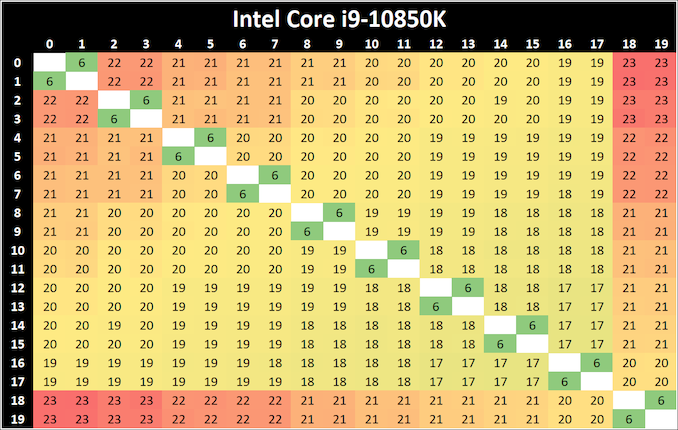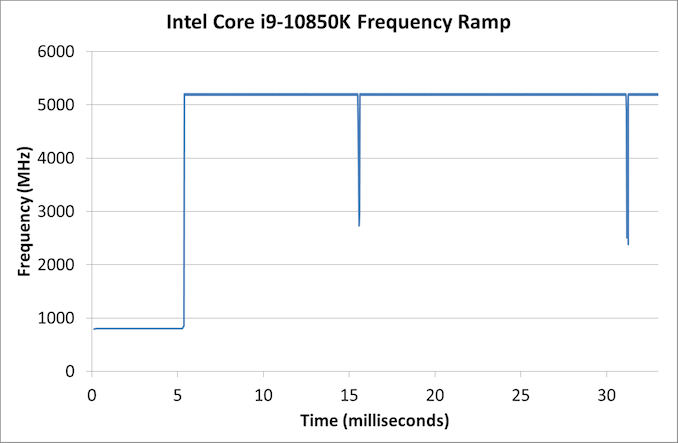Intel Core i9-10850K Review: The Real Intel Flagship
by Dr. Ian Cutress on January 4, 2021 9:00 AM EST- Posted in
- CPUs
- Intel
- Core
- Z490
- 10th Gen Core
- Comet Lake
- LGA1200
- i9-10850K
CPU Tests: Microbenchmarks
Core-to-Core Latency
As the core count of modern CPUs is growing, we are reaching a time when the time to access each core from a different core is no longer a constant. Even before the advent of heterogeneous SoC designs, processors built on large rings or meshes can have different latencies to access the nearest core compared to the furthest core. This rings true especially in multi-socket server environments.
But modern CPUs, even desktop and consumer CPUs, can have variable access latency to get to another core. For example, in the first generation Threadripper CPUs, we had four chips on the package, each with 8 threads, and each with a different core-to-core latency depending on if it was on-die or off-die. This gets more complex with products like Lakefield, which has two different communication buses depending on which core is talking to which.
If you are a regular reader of AnandTech’s CPU reviews, you will recognize our Core-to-Core latency test. It’s a great way to show exactly how groups of cores are laid out on the silicon. This is a custom in-house test built by Andrei, and we know there are competing tests out there, but we feel ours is the most accurate to how quick an access between two cores can happen.
When we first reviewed the 10-core Comet Lake processors, we noticed that a core (or two) seemed to take slightly longer to ping/pong than the others. We see the same pattern here again with the final core.
Frequency Ramping
Both AMD and Intel over the past few years have introduced features to their processors that speed up the time from when a CPU moves from idle into a high powered state. The effect of this means that users can get peak performance quicker, but the biggest knock-on effect for this is with battery life in mobile devices, especially if a system can turbo up quick and turbo down quick, ensuring that it stays in the lowest and most efficient power state for as long as possible.
Intel’s technology is called SpeedShift, although SpeedShift was not enabled until Skylake.
One of the issues though with this technology is that sometimes the adjustments in frequency can be so fast, software cannot detect them. If the frequency is changing on the order of microseconds, but your software is only probing frequency in milliseconds (or seconds), then quick changes will be missed. Not only that, as an observer probing the frequency, you could be affecting the actual turbo performance. When the CPU is changing frequency, it essentially has to pause all compute while it aligns the frequency rate of the whole core.
We wrote an extensive review analysis piece on this, called ‘Reaching for Turbo: Aligning Perception with AMD’s Frequency Metrics’, due to an issue where users were not observing the peak turbo speeds for AMD’s processors.
We got around the issue by making the frequency probing the workload causing the turbo. The software is able to detect frequency adjustments on a microsecond scale, so we can see how well a system can get to those boost frequencies. Our Frequency Ramp tool has already been in use in a number of reviews.
The Core i9-10850K ramps up extremely quickly from idle to peak turbo, in the region of about 5 milliseconds. This is faster than the 16 ms we typically observe.












126 Comments
View All Comments
Cullinaire - Monday, January 4, 2021 - link
Shades of Prescott?😆
Crazyeyeskillah - Tuesday, January 5, 2021 - link
i used to own a PresHottTheinsanegamerN - Tuesday, January 5, 2021 - link
I’d rather PresNotGeoffreyA - Wednesday, January 6, 2021 - link
Somewhat reminiscent.BGADK - Monday, January 4, 2021 - link
Thank you for an interesting article.Availability of Intel CPU's obviously varies a lot across regions. Here in Denmark there is ample supply of the i9-10900K, which is prices 60 euros higher than the i9-10850K. Is it worth it? Before I read the article I would have said "Probably not", but the lower temperatures definitely makes paying a bit more for at better binned CPU a reasonable proposition.
Betabacker - Monday, January 4, 2021 - link
I purchased a 10850k for $380 from BH Photo a couple of months ago. I have a Kraken x73 on it with thermal grizzly paste. I still can't overclock or it'll cook everything. Temps can jump 20 degrees instantly.Nirkon - Tuesday, January 5, 2021 - link
I also bought this CPU but a few weeks ago for that price as well, still waiting for it to arrive though, but I think at that price point there is no better option at the moment, not only because AMD isn't in stock but if you are not using it exclusively for gaming it will for sure offer better future performance at 10c/20t than 6c/12tceomrman - Tuesday, January 5, 2021 - link
I think a lot of people are forgetting how important it is for a vendor to have products to sell. Ryzen 3 can whup Comet Lake on benchmarks all day, but Newegg has exactly zero 5000-series CPUs in stock while they'll ship a 10850k right now for $430. In reality, that means the AMD competition is the 3800X ($417) / 3700X ($325). Those are cheaper, more efficient, and run cooler, but they are also definitely slower (10-15%) at most tasks. The significantly more expensive 3900X ($543) is a step above on many computational tasks and would be my personal choice, but it's still slower than the 10850k at gaming. Buyers don't love getting 2019's leftovers at or above launch MSRP, either, even if they are actually still a good value. That's why it looks like Intel has a good product for its needs. Gamers are likely to choose the Intel CPU, as are some less-hardcore enthusiasts who don't want to wait for current-gen tech. Once AMD stocks the shelves with Zen 3, Intel will have to do better. Until then, it's hard to say a product that you can't buy is better than one you can.Qasar - Tuesday, January 5, 2021 - link
or, one can just be patient, and wait.no one i know who playes games, and is looking for an upgrade is even considering intel now. their current system is fine, so they will be waiting till zen 3 is instock and upgrade then.
gregerst - Tuesday, January 5, 2021 - link
During the course of four or five years of using a 5900x, it would pay for itself many times over by using less electricity vs 10850K. Even the 10900K would make up the price difference over the 10850K. Maybe Intel owns stock in power companies? :D